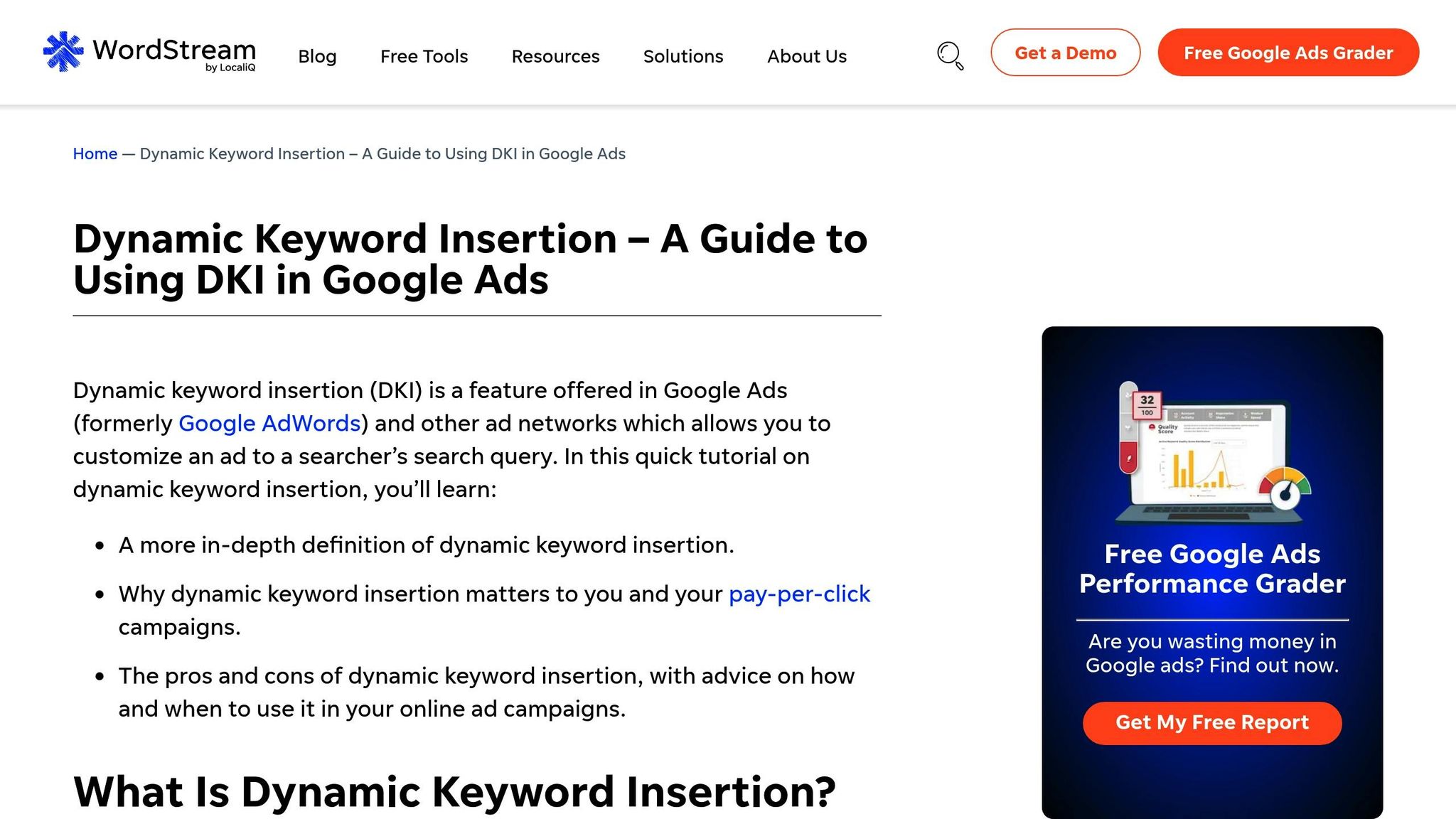Want better ad placements and lower costs in Google Ads? Focus on keyword relevance.
Keyword relevance directly impacts your Quality Score - a metric that determines where your ads appear and how much you pay per click. Here's the quick breakdown:
- Higher Quality Score = Better ad positions + Lower costs
- Key factors: Expected Click-Through Rate (CTR), Ad Relevance, and Landing Page Experience
- Align keywords with ad copy and landing pages for a seamless user experience
To improve your Quality Score:
- Use tightly related keywords in ad groups (10-15 max).
- Optimize landing pages with matching keywords and fast load times.
- Avoid keyword stuffing and irrelevant matches.
- Regularly monitor and refine keywords using performance data.
This alignment ensures higher CTRs, better conversions, and maximizes your ad budget.
Quality Score Basics
What Quality Score Means
Quality Score is a Google Ads metric that rates the performance of your keywords on a scale from 1 to 10. It directly impacts two key areas:
- Your actual cost-per-click (CPC)
- Your ad's position in search results
In short, higher Quality Scores can help you achieve better ad placements at lower costs.
3 Main Quality Score Factors
Google calculates Quality Score based on three key components:
| Component | Weight | Description |
|---|---|---|
| Expected CTR | 45% | Likelihood that users will click your ad |
| Ad Relevance | 30% | How well your ad matches the search intent |
| Landing Page Experience | 25% | How useful and relevant your page is to visitors |
These factors work together, so a weak spot in one area can drag down your overall score. This is why fine-tuning your keywords and ad strategy is so important.
Why Keywords Matter for Quality Score
Keywords play a central role in determining Quality Score. Google evaluates how your keywords align with:
- Historical performance: How similar keywords have performed in your account.
- Account structure: How well-organized your ad groups are around specific keywords.
- Match types: How closely your keywords align with actual search queries.
To keep your keyword relevance strong:
- Focus each ad group on 10-20 closely related keywords.
- Use specific match types to control when your ads appear.
- Regularly check search term reports to spot and remove irrelevant matches.
Since Quality Score updates in real time as your ads run, ongoing keyword optimization is crucial for keeping your campaigns effective.
What is Keyword Quality Score in Google Ads & Why is it ...
Linking Keywords to Ad Performance
This section dives into how your keyword choices directly impact the performance of your ads.
Writing Ads with Strong Keywords
Including the right keywords in your ad copy can improve your Quality Score and make your ads more effective. For example, if you're targeting "organic coffee beans", a headline like "Fresh Organic Coffee Beans" ensures your message is clear and relevant.
Here’s a simple structure to follow: start with your main keyword, add a related term or highlight a benefit, include a call-to-action, and naturally weave in keyword variations within the description.
Using Dynamic Keyword Insertion

Dynamic Keyword Insertion (DKI) adjusts your ad text to match the user's search terms, increasing its relevance. Set up DKI carefully to ensure it aligns with your campaign goals, and monitor its effect on your Quality Score to make adjustments as needed.
Common Keyword Errors to Avoid
Steer clear of these mistakes:
- Keyword stuffing: Overloading your ad copy with keywords can make it look unnatural and hurt performance.
- Misaligned keywords: Using keywords that don’t match your ad’s message or the user’s intent can reduce relevance.
Focus on tightly grouped, related keywords in your ad groups. Regularly check performance data to remove underperforming keywords that don’t align with your campaign objectives. This keeps your ads focused and effective.
sbb-itb-89b8f36
Landing Page Keyword Matching
To achieve a strong Quality Score, your landing page must align closely with your ad and keyword strategy. This ensures relevance and improves user experience.
Matching Page Content to Keywords
Your landing page content should reflect your target keywords and ad messaging. Place the primary keyword naturally in the headline and opening paragraph, and sprinkle variations throughout the page. For instance, if your keyword is "custom kitchen cabinets", your page might cover topics like materials, styles, installation, and customization options.
Focus on these areas:
- Page title and meta description: Include your target keywords here for better search visibility.
- Headers and subheaders: Use variations of your keywords to keep the content natural and engaging.
- Body content: Provide detailed information that matches user search intent.
- Image alt text: Use relevant keywords to describe visuals for accessibility and SEO.
Landing Page Speed and Mobile Setup
A slow-loading page can hurt both user experience and ad performance. Fast page speed is essential for retaining visitors and improving your Quality Score.
Here’s how to improve speed:
- Compress images to reduce load times without losing quality.
- Minimize CSS and JavaScript files to streamline page rendering.
- Enable browser caching to speed up repeat visits.
- Use a content delivery network (CDN) to distribute content efficiently.
Don’t forget mobile optimization. A responsive design ensures your page looks great on any device. Test across various screens, use readable fonts, and simplify forms to improve usability.
User Journey from Ad to Page
Your landing page should deliver on the promises made in your ad, creating a smooth transition for visitors.
Key elements to focus on:
- Message consistency: Reflect the same offer and language as your ad.
- Visual continuity: Maintain similar branding and design elements.
- Clear call-to-action (CTA): Place CTAs prominently, ideally above the fold.
- Trust signals: Include testimonials, certifications, or guarantees to build credibility.
Avoid these common mistakes that disrupt conversions:
- Mismatched messaging: Ensure your landing page matches your ad copy.
- Unclear next steps: Make it obvious what action users should take next.
- Competing elements: Avoid clutter or multiple CTAs that confuse visitors.
- Slow load times: Pages taking longer than 3 seconds to load can drive users away.
Guide visitors through a logical flow that encourages them to take action, while keeping keyword relevance intact throughout their experience. This creates a cohesive and effective landing page.
Steps to Improve Keyword Quality Score
Boosting your Quality Score starts with clear, targeted actions.
Keyword Research Methods
Strong keyword research is the backbone of improving your Quality Score. It helps ensure your keywords align with user intent and campaign goals.
Key areas to focus on:
- Understanding search intent: Know what users are looking for when they search.
- Analyzing competitors: Study what terms your competitors are targeting.
- Tracking trends: Stay updated on shifting search behaviors.
- Exploring long-tail keywords: Target more specific, less competitive phrases.
For tools and expert help, check out resources like the Top PPC Marketing Directory, which connects you with agencies and software to refine your keyword strategy.
Ad Group Organization
Well-organized ad groups are essential for keeping your keywords relevant to your ads.
Here’s how to structure them effectively:
- Group by theme: Limit each group to 10-15 closely related keywords.
- Separate match types: Keep broad, phrase, and exact matches in their own groups.
- Ensure ad relevance: Craft ads that match the keywords in each group.
- Align landing pages: Direct users to pages that match their search intent.
Example ad group themes:
- Custom Kitchen Cabinets
- Kitchen Cabinet Installation
- Modern Kitchen Cabinet Designs
Using Negative Keywords
Negative keywords help filter out irrelevant traffic, boosting click-through rates and saving your budget.
How to use them:
- Regularly review search queries: Identify terms that don’t align with your campaign.
- Monitor broad matches: Prevent irrelevant matches from slipping through.
- Create shared negative lists: Use them across campaigns for consistency.
- Focus on industry-specific exclusions: Avoid terms that don’t apply to your business.
Common categories for negative keywords:
- Competitor names
- Unrelated products or services
- Informational searches (like "how-to" queries)
- Job-related terms (if you're not hiring)
Measuring Keyword Results
Once you've fine-tuned your keyword strategy, the next step is to measure how well it's working. This involves tracking specific metrics and using the data to make informed adjustments.
Key Metrics to Track
Here are the main performance indicators to focus on:
- Click-Through Rate (CTR): Keep an eye on CTR at both the ad and keyword levels for detailed insights into performance.
- Quality Score Components:
- Expected CTR
- Ad relevance
- Landing page experience
- Conversion Metrics:
- Cost per conversion
- Keyword conversion rate
- Return on ad spend (ROAS)
Spotting Underperforming Keywords
To identify keywords that aren't delivering results, look for these warning signs:
- Low Quality Scores: Keywords with low scores often indicate issues like below-average CTR or a poor landing page experience (e.g., high bounce rates).
- High Costs with Low Returns: Keywords with high cost-per-click but minimal conversions or poor relevance scores should be flagged.
Regularly reviewing your keywords helps you quickly address any issues and refine your strategy.
Turning Data Into Action
Use your performance data to make impactful changes by following these steps:
1. Analyze Performance
Dive into historical data to pinpoint high-performing keywords. Look for patterns like strong ad copy alignment, clear user intent, and relevant landing pages.
2. Refine and Optimize
Apply what you've learned from top-performing keywords. Adjust match types, improve ad copy, and ensure your landing pages align with user intent.
3. Monitor Continuously
Keep tracking Quality Score trends, conversion rates, and other metrics to ensure your optimizations are effective. Use this data to make ongoing tweaks.
For deeper insights and better tracking, consider using advanced PPC management tools like those listed in the Top PPC Marketing Directory. They can help you stay on top of your campaigns and make smarter adjustments.
Conclusion
The success of PPC campaigns heavily depends on choosing the right keywords. Relevant keywords improve Quality Scores, enhance ad performance, and help businesses achieve better positions at reduced costs.
Here’s why aligning keywords with ads and landing pages matters:
- Higher Quality Scores mean better ad placements for less money.
- Strong keyword-to-ad alignment increases click-through rates (CTR).
- Relevant landing pages improve conversion rates, while using negative keywords helps reduce unnecessary spending.
Regularly reviewing performance metrics and updating keyword lists ensures your landing pages meet user expectations. For help managing complex campaigns or optimizing strategies, check out the Top PPC Marketing Directory for specialized tools and expert agencies.


